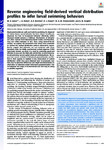Reverse engineering field-derived vertical distribution profiles to infer larval swimming behaviors
| dc.contributor.author | James, Molly | |
| dc.contributor.author | Polton, J | |
| dc.contributor.author | Brereton, A | |
| dc.contributor.author | Howell, Kerry | |
| dc.contributor.author | Nimmo-Smith, Alex | |
| dc.contributor.author | Knights, Antony | |
| dc.date.accessioned | 2019-05-24T08:22:46Z | |
| dc.date.issued | 2019-06 | |
| dc.identifier.issn | 0027-8424 | |
| dc.identifier.issn | 1091-6490 | |
| dc.identifier.uri | http://hdl.handle.net/10026.1/14205 | |
| dc.description.abstract |
Biophysical models are well-used tools for predicting the dispersal of marine larvae. Larval behavior has been shown to influence dispersal, but how to incorporate behavior effectively within dispersal models remains a challenge. Mechanisms of behavior are often derived from laboratory-based studies and therefore, may not reflect behavior in situ. Here, using state-of-the-art models, we explore the movements that larvae must undertake to achieve the vertical distribution patterns observed in nature. Results suggest that behaviors are not consistent with those described under the tidally synchronized vertical migration (TVM) hypothesis. Instead, we show (i) a need for swimming speed and direction to vary over the tidal cycle and (ii) that, in some instances, larval swimming cannot explain observed vertical patterns. We argue that current methods of behavioral parameterization are limited in their capacity to replicate in situ observations of vertical distribution, which may cause dispersal error to propagate over time, due to advective differences over depth and demonstrate an alternative to laboratory-based behavioral parameterization that encompasses the range of environmental cues that may be acting on planktic organisms. | |
| dc.format.extent | 11818-11823 | |
| dc.format.medium | Print-Electronic | |
| dc.language | en | |
| dc.language.iso | en | |
| dc.publisher | National Academy of Sciences | |
| dc.subject | larval behaviour | |
| dc.subject | Vertical migration | |
| dc.subject | larval swimming | |
| dc.subject | reverse engineering | |
| dc.subject | biophysical modelling | |
| dc.title | Reverse engineering field-derived vertical distribution profiles to infer larval swimming behaviors | |
| dc.type | journal-article | |
| dc.type | Journal Article | |
| dc.type | Research Support, Non-U.S. Gov't | |
| plymouth.author-url | https://www.webofscience.com/api/gateway?GWVersion=2&SrcApp=PARTNER_APP&SrcAuth=LinksAMR&KeyUT=WOS:000471039700043&DestLinkType=FullRecord&DestApp=ALL_WOS&UsrCustomerID=11bb513d99f797142bcfeffcc58ea008 | |
| plymouth.issue | 24 | |
| plymouth.volume | 116 | |
| plymouth.publication-status | Published | |
| plymouth.journal | Proceedings of the National Academy of Sciences of the United States of America | |
| dc.identifier.doi | 10.1073/pnas.1900238116 | |
| plymouth.organisational-group | /Plymouth | |
| plymouth.organisational-group | /Plymouth/Faculty of Science and Engineering | |
| plymouth.organisational-group | /Plymouth/Faculty of Science and Engineering/School of Biological and Marine Sciences | |
| plymouth.organisational-group | /Plymouth/PRIMaRE Publications | |
| plymouth.organisational-group | /Plymouth/REF 2021 Researchers by UoA | |
| plymouth.organisational-group | /Plymouth/REF 2021 Researchers by UoA/UoA07 Earth Systems and Environmental Sciences | |
| plymouth.organisational-group | /Plymouth/Research Groups | |
| plymouth.organisational-group | /Plymouth/Research Groups/Marine Institute | |
| plymouth.organisational-group | /Plymouth/Users by role | |
| plymouth.organisational-group | /Plymouth/Users by role/Academics | |
| plymouth.organisational-group | /Plymouth/Users by role/Researchers in ResearchFish submission | |
| dc.publisher.place | United States | |
| dcterms.dateAccepted | 2019-05-04 | |
| dc.rights.embargodate | 2019-11-23 | |
| dc.identifier.eissn | 1091-6490 | |
| dc.rights.embargoperiod | Not known | |
| rioxxterms.versionofrecord | 10.1073/pnas.1900238116 | |
| rioxxterms.licenseref.uri | http://www.rioxx.net/licenses/all-rights-reserved | |
| rioxxterms.licenseref.startdate | 2019-06 | |
| rioxxterms.type | Journal Article/Review |


